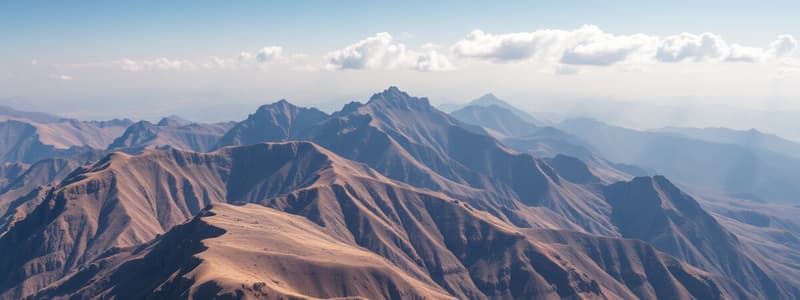Podcast
Questions and Answers
Which of the following is NOT a key component of Physical Geography?
Which of the following is NOT a key component of Physical Geography?
- Population Geography (correct)
- Soils
- Hydrology
- Climate and Weather
Human Geography examines only the cultural aspects of human activities.
Human Geography examines only the cultural aspects of human activities.
False (B)
What is the primary purpose of Geographic Information Systems (GIS)?
What is the primary purpose of Geographic Information Systems (GIS)?
To capture, manage, analyze, and display geographic data.
The study of the interactions between humans and the environment is known as _____ Geography.
The study of the interactions between humans and the environment is known as _____ Geography.
Match the following components with their correct definitions:
Match the following components with their correct definitions:
Which GIS software is known for its wide use in urban planning and environmental monitoring?
Which GIS software is known for its wide use in urban planning and environmental monitoring?
Cultural landscapes are solely defined by natural features.
Cultural landscapes are solely defined by natural features.
What is symbolic landscape?
What is symbolic landscape?
The visible imprint of human activity on the landscape is referred to as a _____ landscape.
The visible imprint of human activity on the landscape is referred to as a _____ landscape.
Which of the following is NOT an application of Geographic Information Systems?
Which of the following is NOT an application of Geographic Information Systems?
Study Notes
Physical Geography
- Definition: Study of natural features and processes of the Earth.
- Key Components:
- Landforms: Mountains, valleys, plateaus, plains.
- Climate and Weather: Patterns, systems, and effects on ecosystems.
- Soils: Types, formation, and impact on agriculture.
- Hydrology: Water bodies, cycles, and their importance.
- Biogeography: Distribution of flora and fauna.
Human Geography
- Definition: Examination of human activities and their relationship with the environment.
- Key Components:
- Population Geography: Distribution, density, and demographics.
- Cultural Geography: Language, religion, and ethnicity.
- Economic Geography: Industry, agriculture, services, and trade.
- Political Geography: Borders, governance, and territorial disputes.
- Urban Geography: City development, urbanization, and planning.
Geographic Information Systems (GIS)
- Definition: Technology for capturing, managing, analyzing, and displaying geographic data.
- Key Components:
- Data Types: Vector (points, lines, polygons) and raster (gridded data).
- Applications: Urban planning, environmental monitoring, transportation, disaster management.
- Analysis Techniques: Spatial analysis, overlay analysis, and geostatistics.
- Software: ArcGIS, QGIS, and Google Earth.
Cultural Landscapes
- Definition: The visible imprint of human activity on the landscape.
- Key Components:
- Land Use: Agricultural, residential, industrial, and commercial.
- Architecture: Styles reflecting cultural identity and historical influences.
- Symbolic Landscapes: Sites with cultural or spiritual significance (e.g., monuments, sacred sites).
- Cultural Diffusion: Spread of cultural practices and impacts on landscapes.
Environmental Geography
- Definition: Study of the interactions between humans and the environment.
- Key Components:
- Natural Resource Management: Sustainable practices, conservation efforts.
- Environmental Degradation: Pollution, deforestation, and climate change impacts.
- Ecological Footprint: Measurement of human demand on Earth’s ecosystems.
- Global Environmental Issues: Climate change, biodiversity loss, and water scarcity.
Physical Geography
- Encompasses the study of Earth's natural features and processes.
- Key landforms include mountains, valleys, plateaus, and plains that shape the landscape.
- Examines climate and weather patterns, their systems, and their effects on ecosystems.
- Investigates soils, including their types and formation, which significantly impact agriculture.
- Hydrology focuses on water bodies and cycles, essential for sustaining life and ecosystems.
- Biogeography addresses the distribution and diversity of flora and fauna across different environments.
Human Geography
- Explores human activities and their interactions with the natural environment.
- Population geography assesses the distribution, density, and demographic characteristics of populations.
- Cultural geography examines aspects such as language, religion, and ethnicity that shape communities.
- Economic geography analyzes industries, agriculture, services, and trade practices within regions.
- Political geography studies borders, governance systems, and territorial disputes among nations.
- Urban geography focuses on city development, urbanization trends, and planning methodologies.
Geographic Information Systems (GIS)
- Involves technology for acquiring, managing, analyzing, and presenting geographic data.
- Data types include vector formats (points, lines, polygons) and raster formats (gridded data).
- Applied in various fields including urban planning, environmental monitoring, and disaster management.
- Employs analytical techniques such as spatial analysis, overlay analysis, and geostatistics.
- Common GIS software includes ArcGIS, QGIS, and Google Earth for data visualization and analysis.
Cultural Landscapes
- Represents the visible imprints of human activities on the natural landscape.
- Land use includes agricultural, residential, industrial, and commercial developments impacting geography.
- Architecture reflects cultural identities and historical influences within built environments.
- Symbolic landscapes encompass sites of cultural or spiritual significance, including monuments and sacred areas.
- Cultural diffusion refers to the spread and influence of cultural practices, reshaping landscapes over time.
Environmental Geography
- Examines the complex interactions between human societies and their environments.
- Natural resource management emphasizes sustainable practices and conservation initiatives to protect ecosystems.
- Environmental degradation includes issues like pollution, deforestation, and the impacts of climate change.
- The ecological footprint measures the human demand on Earth's resources and ecosystems.
- Global environmental issues involve pressing challenges such as climate change, biodiversity loss, and water scarcity affecting societies worldwide.
Studying That Suits You
Use AI to generate personalized quizzes and flashcards to suit your learning preferences.
Description
Explore the essential concepts of Physical and Human Geography. This quiz covers key components such as landforms, climate, population distribution, and more. Test your knowledge on how these elements interact and shape our world.



